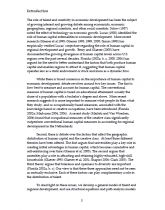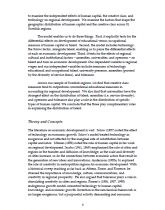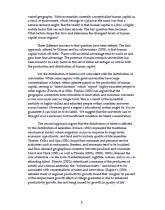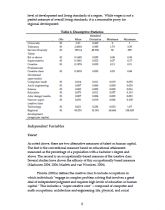Hledej
Zobraz:
Univerzity
Kategorie
Rozšířené vyhledávání
12 662
projektů
The Creative Class or Human Capital?
| Přípona |
Typ projekt |
Stažené 0 x |
| Velikost 0,4 MB |
Jazyk anglický |
ID projektu 2933 |
| Poslední úprava 27.03.2014 |
Zobrazeno 1 586 x |
Autor: eliseus |
 Sdílej na Facebooku
Sdílej na Facebooku |
||
| Detaily projektu | ||
- Cena:
2 Kreditů - kvalita:
88,8% -
Stáhni
- Přidej na srovnání
- Univerzita:Univerzita Tomáše Bati ve Zlíně
- Fakulta:Fakulta managementu a ekonomiky
- Kategorie:Ekonomika » Management
- Předmět:Management
- Studijní obor:-
- Ročník:-
- Formát:PDF dokument (.pdf)
- Rozsah A4:39 stran
The role of talent and creativity in economic development has been a subject
of growing interest to social scientists. Human capital is observed both to be
an important contributor to growth and to be unevenly distributed
geographically.
While there is consensus on the importance of human capital to economic
development, debate takes shape around two central issues. First, there is the
question of how best to measure human capital. The conventional measure of
human capital is based on educational attainment (share of population with a
bachelors degree and above). But more recent research suggests that it is
more important to measure what people do than what they study, and thus
occupationally based measures, associated principally with creative class
occupations, have been introduced. Second, there is debate over the factors
that yield the geographic distribution of human capital in the first place.
Three alternative factors have been found to play a role: universities;
amenities (measured here as diversity of service industries); and openness
and tolerance.
of growing interest to social scientists. Human capital is observed both to be
an important contributor to growth and to be unevenly distributed
geographically.
While there is consensus on the importance of human capital to economic
development, debate takes shape around two central issues. First, there is the
question of how best to measure human capital. The conventional measure of
human capital is based on educational attainment (share of population with a
bachelors degree and above). But more recent research suggests that it is
more important to measure what people do than what they study, and thus
occupationally based measures, associated principally with creative class
occupations, have been introduced. Second, there is debate over the factors
that yield the geographic distribution of human capital in the first place.
Three alternative factors have been found to play a role: universities;
amenities (measured here as diversity of service industries); and openness
and tolerance.
Klíčová slova:
creativity
economic
development
factors
industries
Obsah:
- Executive Summary
Introduction
Theory and Concepts
Model, variables, and methods
Variables
Independent Variables
Methods
Findings
Results from path analysis and structural equations models
Human Capital (BA university degree or more)
Creative Class
Super-creatives
References
Zdroje:
- Andersson, Å. E. 1985a. Creativity and Regional Development. Papers of the Regional Science Association. 56:5-20.
- Andersson, Å. E. 1985b. Creativity The Future of Metropolitan Regions. Stockholm: Prisma.
- Barro, R. J. 1991. Economic Growth in a Cross Section of Countries. Quarterly Journal of Economics. 106(2): 407-443.
- Berry, C. R., Glaeser, E. L. 2005. The Divergence of Human Capital Levels Across Cities. NBER Working Paper No. 11617. September 2005.
- Clark, T. N., Lloyd, R., Wong, K. K., Jain, P. 2002. Amenities Drive Urban Growth. Journal of Urban Affairs. 24:5: 493-515.
- Clark, T. N. 2003. Urban Amenities: Lakes, Opera and Juice Bars Do They Drive Development? In: The City as an Entertainment Machine. Research in Urban Policy. Volume 9: 103-140. Oxford: Elsevier Ltd.
- Florida, R., Gates, G. 2001. Technology and Tolerance The Importance of Diversity to High-Technology Growth, Urban Institute, June 01
- Florida, R. 2002a. The Rise of the Creative Class. New York: Basic Books.
- Florida, R. 2002b. The Economic Geography of Talent. Annals of the Association of American Geographers. 92(4): 743-755.
- Florida, R. 2002c. Bohemia and economic geography. Journal of Economic Geography. 2: 55-71.
- Florida, R. 2004. Response to Edward Gleasers review of The Rise of the Creative Class. http://www.creativeclass.org/acrobat/ResponsetoGlaeser.pdf
- Florida, R. 2005. Cities and the Creative Class. New York: Routledge.
- Florida, R., Gates, G., Knudsen, B., Stolarick, K. 2006. The University and the Creative Economy.
- http://www.creativeclass.org/rfcgdb/articles/University%20For%20City%20and%20Community%204.pdf



